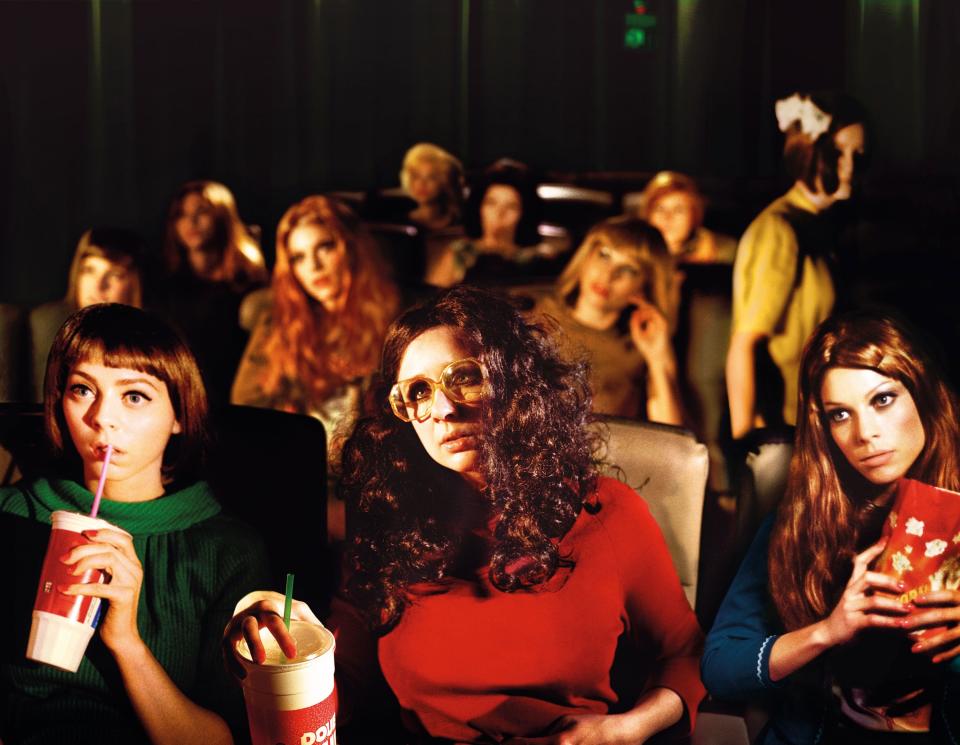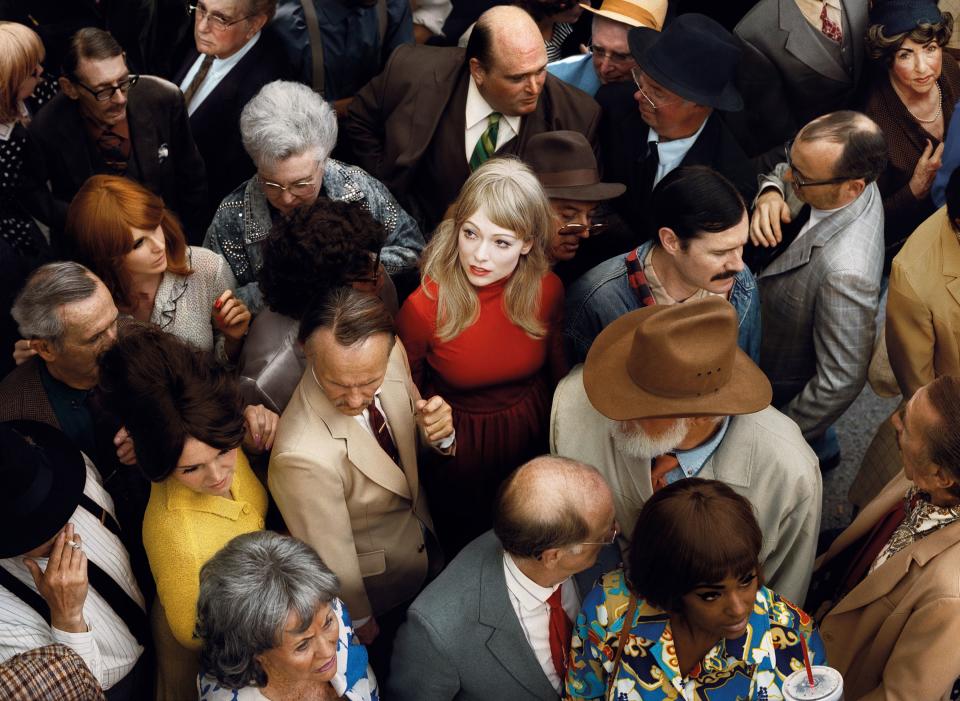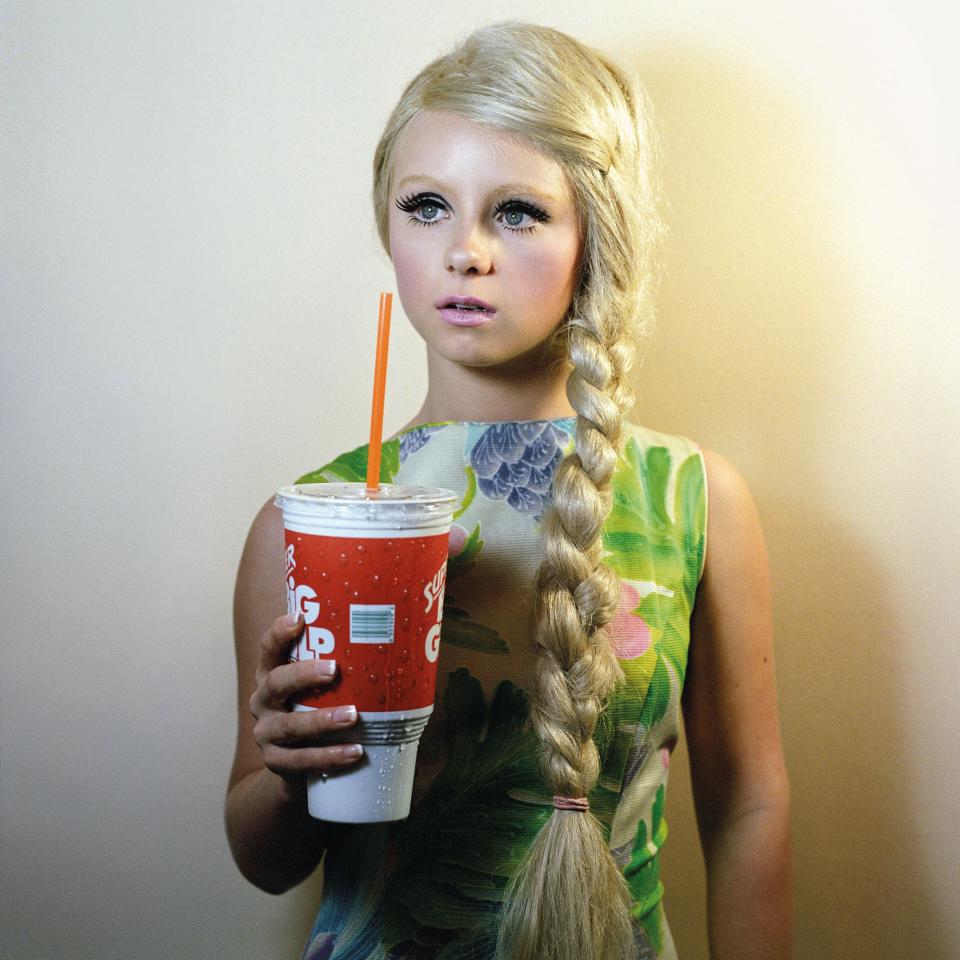Alex Prager Wants to Make You Look Twice
Usually, as I’m scurrying from the subway to the bottom of my office’s elevator bank via the underground luxury mall–cum–transportation hub that is the Santiago Calatrava–designed lower Manhattan landmark, my peripheral vision is crowded by high-def LED advertisements that ostensibly subsidize my weather-shielded passage. But last month, actress Elizabeth Banks stared back at me—or, rather, Elizabeth Banks transformed via the work of photographer and filmmaker Alex Prager. In the scene projected on the wall, Banks was part of a crowded space, where the friction of strangers brushing up against one another gave the goings-on a mysterious charge.
Prager’s work is often galvanized with some difficult-to-define electricity, an energy built from the inherent conflicts contained within it. Her subjects eyes’ have both a startling intensity and a vacancy; the clothes are both dated by their particular shade of teal or flamingo pink and somehow timeless; in the crowds she depicts, there are moments of intimacy and proximity, and yet they reverberate with barely submerged loneliness. All this is celebrated this month not just in the excerpt from Prager’s film Face in the Crowd, which is playing at One World Trade Center, but in a new book, her first monograph, Silver Lake Drive, published by Chronicle Books.
The book covers a 10-year period, a span that, as Prager put it to me over the phone, represents a coherent period in her work—a time in which she probed the “line between reality and artifice, and the raw emotion that is kept just beneath a very constructed surface.” Those surfaces are indeed intriguing in a Prager photograph. In an essay published in the monograph, Michael Govan, director of the Los Angeles County Museum of Art, writes, “They sent my own gaze darting across the composition as if scanning the surface of an Abstract Expressionist painting.” And as in the work of Pollock or Rothko or other Abstract Expressionist heavyweights, there is an atomic and universal quality to her art; you’re never quite sure if you should be focusing on a single square inch or taking in the whole cosmos she has assembled.
A few days after the publication of her book, I spoke with the artist about three different photos within and the evolution they represent:
“At the time, my grandmother’s friend had given me a few boxes of her old clothes. She was a Hollywood starlet, and she had all of these amazing handmade costumes and wigs that she used to wear to perform in,” Prager told me about her photograph Ellen, above. “I’d already been thinking about the line between reality and artifice, and this box of wigs and costumes brought an extra level to the photograph. The model was a friend of a friend, and she had this very doll-like quality to her and yet she was a real person. I did the braid myself because I didn’t want it to look professional. I wasn’t trying to situate the photo in any era in particular. I’m always interested in giving people hints of what they’re looking at but never letting them be 100 percent sure. I’m interested in throwing people off, making them second-guess what they’re looking at. Sometimes people think they’re looking at a photo that was shot in the 1960s, but then there are props that give a sense of a different era. I love using things that we’re accustomed to seeing—something you can buy at 7-Eleven, for example, or anywhere around the world. And I love using props that speak to the nostalgia in you, since I see nostalgia itself as inherently comforting. When you look at this person, you see a young person wearing way too much makeup, completely covered from head to toe—and that’s disquieting. But then there’s the comfort, too: the colors she’s wearing and the familiarity of the object she’s holding. At this stage, I hadn’t started thinking of my subjects in terms of backstory. In the beginning, my ideas about character were always based on emotion. I would give the subject ideas based on what emotion I was trying to get her to portray on her face. But you have to be very specific to get things out of people—you can’t just say ‘look sad.’

This was shot in a movie theater near where I grew up, and near where I live now. I watched movies there as a kid and I still watch movies there. I wanted to see a theater filled with all of my girlfriends; I was interested in making an image of all women watching the same movie, but not reveal what it was—a romance or a kung fu film. All the people in this photo are my friends or friends of friends—it was taken before I started using central casting and extras. I would call my friend and she would say, ‘Actually, I was going to hang out with Sarah. Is it okay if I bring her?’ And I would say, ‘Text me a picture of her.’ Most of the time, I try to hire people I know. It lends itself to a different dynamic. There’s something strange that happens when my sister or my mom is in the middle of all these extras; if I tell my sister to adjust something, the extras might realize that she’s important to me and move closer. It brings up more emotions—jealousy, envy—and it shifts the route machine that they’re used to being a part of when they sign up to be an extra.
The challenges surrounding this shoot were technical. I remember clearly how difficult it was to place and light everyone. I was working with just a photo assistant, a friend who offered to help out. And we were using a mix of lights from Home Depot, trying to make something that was good enough to share. It helps that for the first five or seven years, I was doing everything with just one person helping me, because I really understand lighting now. You can’t really say to me, ‘That’s not possible.’ Because I tried it all. I figured out what was possible.

The whole idea of Face in the Crowd is questioning: Does the crowd feel safe? Does it feel overwhelming? This piece was designed to be shown in a dark, immersive space. The only other exhibition space that feels right to me is somewhere like the World Trade Center or Times Square, where it was also shown. When it was shown in those spaces, it felt like the crowd that was walking by could have been part of one of the montages. It made the crowd in the film feel more real, and the crowd that I was standing in feel more artificial. And it got me thinking about how we costume ourselves for the day and where all these people were going.


